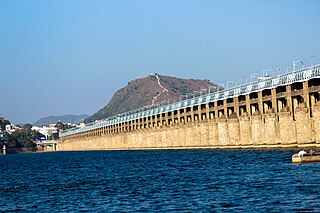
The Indus is a transboundary river of Asia and a trans-Himalayan river of South and Central Asia. The 3,180 km (1,980 mi) river rises in mountain springs northeast of Mount Kailash in Western Tibet, flows northwest through the disputed region of Kashmir, bends sharply to the left after the Nanga Parbat massif, and flows south-by-southwest through Pakistan, before emptying into the Arabian Sea near the port city of Karachi.

The Krishna River in the Deccan plateau is the third-longest river in India, after the Ganges and Godavari. It is also the fourth-largest in terms of water inflows and river basin area in India, after the Ganges, Indus and Godavari. The river, also called Krishnaveni, is 1,400 kilometres (870 mi) long and its length in Maharashtra is 282 kilometres. It is a major source of irrigation in the Indian states of Maharashtra, Karnataka, Telangana and Andhra Pradesh.

The Godavari is India's second longest river after the Ganga River and drains the third largest basin in India, covering about 10% of India's total geographical area. Its source is in Trimbakeshwar, Nashik, Maharashtra. It flows east for 1,465 kilometres (910 mi), draining the states of Maharashtra (48.6%), Telangana (18.8%), Andhra Pradesh (4.5%), Chhattisgarh (10.9%) and Odisha (5.7%). The river ultimately empties into the Bay of Bengal through an extensive network of distributaries. Measuring up to 312,812 km2 (120,777 sq mi), it forms one of the largest river basins in the Indian subcontinent, with only the Ganga and Indus rivers having a larger drainage basin. In terms of length, catchment area and discharge, the Godavari is the largest in peninsular India, and had been dubbed as the Dakshina Ganga.

Coimbatore, sometimes shortened as Kovai, is one of the major metropolitan cities in the Indian state of Tamil Nadu. It is located on the banks of the Noyyal River and surrounded by the Western Ghats. Coimbatore is the second largest city in Tamil Nadu after Chennai in terms of population and the 16th largest urban agglomeration in India as per the census 2011. It is the administrative capital of Coimbatore District and is administered by the Coimbatore Municipal Corporation which was established in 1981.

The Yamuna is the second-largest tributary river of the Ganges by discharge and the longest tributary in India. Originating from the Yamunotri Glacier at a height of about 4,500 m (14,800 ft) on the southwestern slopes of Bandarpunch peaks of the Lower Himalaya in Uttarakhand, it travels 1,376 kilometres (855 mi) and has a drainage system of 366,223 square kilometres (141,399 sq mi), 40.2% of the entire Ganges Basin. It merges with the Ganges at Triveni Sangam, Prayagraj, which is a site of the Kumbh Mela, a Hindu festival held every 12 years.

Vijayawada, popularly known by its colonial name Bezawada, is the second largest city and commercial hub in the Indian state of Andhra Pradesh. The city is part of the Andhra Pradesh Capital Region and is located on the banks of the Krishna River surrounded by the hills of the Eastern Ghats, known as the Indrakeeladri Hills. The city is home to the important Hindu shrine of Kanaka Durga Temple. It geographically lies on the center spot of Andhra Pradesh. The city has been described as the commercial, political, cultural and educational capital of Andhra Pradesh. It is the administrative headquarters of NTR district. The Prakasam Barrage across the Krishna River connects the NTR and Guntur districts.

Sukkur is a city in the Pakistani province of Sindh along the western bank of the Indus River, directly across from the historic city of Rohri. Sukkur is the third largest city in Sindh after Karachi and Hyderabad, and 14th largest city of Pakistan by population. The city was originally founded by the Rai dynasty of Sindh. The modern city was built in the 1840s. New Sukkur was established during the British era alongside the village of Sukkur. Sukkur's hill, along with the hill on the river island of Bukkur, form what is sometimes considered the "Gate of Sindh".

The Tees Barrage is a barrage and road bridge across the River Tees, Northern England, just upriver of Blue House Point and is used to control the flow of the river, preventing flooding and the effects of tidal change. It is between the towns of Stockton-on-Tees and Thornaby, road access is only by the latter with limited road access to the Tees's north bank.

The Subarnarekha River flows through the Indian states of Jharkhand, West Bengal and Odisha.

The Severn Barrage is any of a range of ideas for building a barrage from the English coast to the Welsh coast over the Severn tidal estuary. Ideas for damming or barraging the Severn estuary have existed since the 19th century. The building of such a barrage would constitute an engineering project comparable with some of the world's biggest. The purposes of such a project have typically been one or several of: transport links, flood protection, harbour creation, or tidal power generation. In recent decades it is the latter that has grown to be the primary focus for barrage ideas, and the others are now seen as useful side-effects. Following the Severn Tidal Power Feasibility Study (2008–10), the British government concluded that there was no strategic case for building a barrage but to continue to investigate emerging technologies. In June 2013 the Energy and Climate Change Select Committee published its findings after an eight-month study of the arguments for and against the Barrage. MPs said the case for the barrage was unproven. They were not convinced the economic case was strong enough and said the developer, Hafren Power, had failed to answer serious environmental and economic concerns.
Anti-Indian sentiment or anti-Indianism, also called Indophobia, refers to prejudice, collective hatred, and discrimination which is directed at Indian people for any variety of reasons. It may be rooted in a person's negative perception of India, Indian culture, or Indian history, among other factors. According to Kenyan-American academic Ali Mazrui, Indophobia is "a tendency to react negatively towards people of Indian extraction, against aspects of Indian culture and normative habits." As such, it is the opposite of Indomania, which refers to a pronounced affinity for Indians and their culture, history, and country. Anti-Indian sentiment is frequently a manifestation of racism, particularly in cases in which Indians are targeted alongside other South Asians or simply alongside any other people of colour. Regardless of their motivation, Indophobic individuals often invoke stereotypes of Indians to justify their feelings or attitudes towards them. Persecution of Hindus is the most prominent form of Indophobia.
Farrakka Barrage Township is a census town in the Farakka CD block in the Jangipur subdivision of the Murshidabad district in the state of West Bengal, India.
The Upper Krishna Project (UKP) is an irrigation project across the Krishna River to provide irrigation to the drought-prone areas of Vijayapura district, Karnataka, Bagalkot, Kalburgi, Yadgir and Raichur districts in the state of Karnataka in south India. The project had been designed by the Government of Karnataka to irrigate 1,536,000 acres of land (6,220 km2).

The ongoing pollution of the Ganges, the largest river in the Indian subcontinent, poses a significant threat to both human health and the environment. The river supplies water to approximately 40% of India's population across 11 states and serves an estimated 500 million people—more than any other river in the world.
Khajipeta is a village in Kadapa district of the Indian state of Andhra Pradesh. It is located in Khajipet mandal of Badvel revenue division.
The Ganges Barrage, officially named as the Lav Khush Barrage, is a bridge across the Ganges river at Azad Nagar-Nawabganj in Kanpur.
The Pulichintala Project is a multi-purpose water management project for irrigation, hydropower generation, and flood control in the state of Andhra Pradesh, India. It is a crucial irrigation facility for farmers in four coastal districts: West Godavari, Krishna, Guntur, Palanadu, and Prakasam, covering over 13 lakh acres. It has 24 gates and a balancing reservoir with a capacity of 46 Tmcft at 175 feet (53 m) MSL full reservoir level (FRL).

Sripada Yellampalli Project is an irrigation project located at Yellampalli Village of Ramagundam rural Mandal, between Peddapalli district - Mancherial District of Telangana State, India. The project is fourth largest on the Godavari River in Telangana State. It is named after late legislator, D. Sripada Rao.

Mylavaram Dam is a medium irrigation project in Andhra Pradesh, India. This barrage is located across the Penna river in Kadapa district near Mylavaram. With the completion of srisailam right bank canal, Krishna River water would be fed from Srisailam reservoir to this reservoir. The reservoir has a gross storage capacity of 9.96 tmcft.

Black Lagoon is a Japanese anime television series based on the manga series of the same title by Rei Hiroe. The series was produced by Madhouse, Geneon Entertainment and Shogakukan and directed and written by Sunao Katabuchi, with Masanori Shino designing the characters and Edison composing the music. The first season was broadcast in Japan from April to June 2006; it was followed by a second season, titled The Second Barrage, broadcast from October to December of the same year. A five-episode original video animation (OVA), subtitled Roberta's Blood Trail, was launched from July 2010 to June 2011. In North America, the anime series was originally licensed by Geneon Entertainment in 2006 and was later acquired by Funimation in 2008, who also licensed the OVA and released it in 2013.















